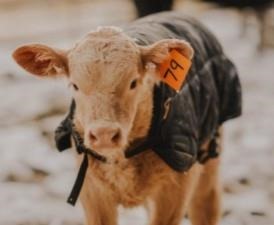What is cold stress?
All mammals need to maintain their internal body temperatures, averaging 38°C in cattle. However, they don’t need to use extra energy to maintain normal body temperatures when the environmental conditions are within a “thermoneutral zone.” The thermoneutral zone is defined as the range of ambient temperatures without regulatory changes in metabolic heat production or evaporative heat loss.

When environmental temperatures drop below this zone, their body becomes stressed (hence the term cold stress). So, their body will increase its metabolic rate to maintain average temperatures. If the animal cannot maintain its body temperature, it will experience hypothermia. If severe enough, the animal will need medical intervention.
Below are estimates of lower critical temperatures for beef cattle. Keep in mind that these estimates do not consider various factors that may impact an animal’s threshold (e.g. condition of the animal and wind chill).
Estimates of lower critical temperatures for beef cattle in different seasons*
| Season | Lower Critical Temperature |
|---|
| Summer | 15°C |
| Fall | 7°C |
| Early winter | 0°C |
| Late winter | -8°C |
*Assuming that the animal is not susceptible to cold stress due to age, disease, poor condition, poor hair coat, and no wind chill.
Why may cold stress be more of a concern this year?
Most of the beef cattle raised in Canada acclimate to winter quickly. Very young, old, and ill animals are more susceptible to cold stress, especially those without good fat coverage.
This is why we recommend that cattle should be in good condition going into winter (i.e., Body Condition Score of 3). However, this may be a challenge for beef producers due to the recent drought and feed shortages.
What are the signs of cold stress in beef cattle?
In beef cattle, the following are signs of cold stress.
- Calves won’t suckle a bottle or fingers
- Depression, fatigue, unwillingness to move, and going down
- Fresh frostbite
- Low body temperature (<35°C)
- Pale gums
- Shivering (but may stop if the condition becomes severe)
- Skin or mouth is cold to the touch
Click here to see more...